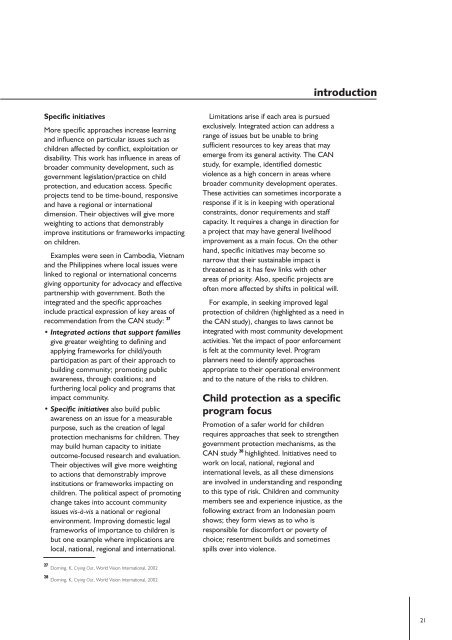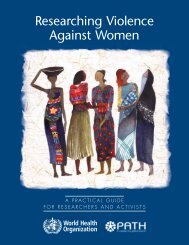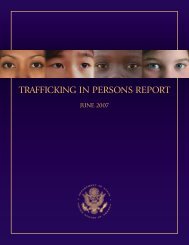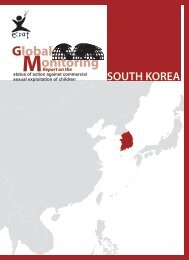Download PDF - Violence Against Children - East Asia and the ...
Download PDF - Violence Against Children - East Asia and the ...
Download PDF - Violence Against Children - East Asia and the ...
You also want an ePaper? Increase the reach of your titles
YUMPU automatically turns print PDFs into web optimized ePapers that Google loves.
introduction<br />
Specific initiatives<br />
More specific approaches increase learning<br />
<strong>and</strong> influence on particular issues such as<br />
children affected by conflict, exploitation or<br />
disability. This work has influence in areas of<br />
broader community development, such as<br />
government legislation/practice on child<br />
protection, <strong>and</strong> education access. Specific<br />
projects tend to be time-bound, responsive<br />
<strong>and</strong> have a regional or international<br />
dimension. Their objectives will give more<br />
weighting to actions that demonstrably<br />
improve institutions or frameworks impacting<br />
on children.<br />
Examples were seen in Cambodia, Vietnam<br />
<strong>and</strong> <strong>the</strong> Philippines where local issues were<br />
linked to regional or international concerns<br />
giving opportunity for advocacy <strong>and</strong> effective<br />
partnership with government. Both <strong>the</strong><br />
integrated <strong>and</strong> <strong>the</strong> specific approaches<br />
include practical expression of key areas of<br />
recommendation from <strong>the</strong> CAN study: 27<br />
• Integrated actions that support families<br />
give greater weighting to defining <strong>and</strong><br />
applying frameworks for child/youth<br />
participation as part of <strong>the</strong>ir approach to<br />
building community; promoting public<br />
awareness, through coalitions; <strong>and</strong><br />
fur<strong>the</strong>ring local policy <strong>and</strong> programs that<br />
impact community.<br />
• Specific initiatives also build public<br />
awareness on an issue for a measurable<br />
purpose, such as <strong>the</strong> creation of legal<br />
protection mechanisms for children. They<br />
may build human capacity to initiate<br />
outcome-focused research <strong>and</strong> evaluation.<br />
Their objectives will give more weighting<br />
to actions that demonstrably improve<br />
institutions or frameworks impacting on<br />
children. The political aspect of promoting<br />
change takes into account community<br />
issues vis-à-vis a national or regional<br />
environment. Improving domestic legal<br />
frameworks of importance to children is<br />
but one example where implications are<br />
local, national, regional <strong>and</strong> international.<br />
Limitations arise if each area is pursued<br />
exclusively. Integrated action can address a<br />
range of issues but be unable to bring<br />
sufficient resources to key areas that may<br />
emerge from its general activity. The CAN<br />
study, for example, identified domestic<br />
violence as a high concern in areas where<br />
broader community development operates.<br />
These activities can sometimes incorporate a<br />
response if it is in keeping with operational<br />
constraints, donor requirements <strong>and</strong> staff<br />
capacity. It requires a change in direction for<br />
a project that may have general livelihood<br />
improvement as a main focus. On <strong>the</strong> o<strong>the</strong>r<br />
h<strong>and</strong>, specific initiatives may become so<br />
narrow that <strong>the</strong>ir sustainable impact is<br />
threatened as it has few links with o<strong>the</strong>r<br />
areas of priority. Also, specific projects are<br />
often more affected by shifts in political will.<br />
For example, in seeking improved legal<br />
protection of children (highlighted as a need in<br />
<strong>the</strong> CAN study), changes to laws cannot be<br />
integrated with most community development<br />
activities. Yet <strong>the</strong> impact of poor enforcement<br />
is felt at <strong>the</strong> community level. Program<br />
planners need to identify approaches<br />
appropriate to <strong>the</strong>ir operational environment<br />
<strong>and</strong> to <strong>the</strong> nature of <strong>the</strong> risks to children.<br />
Child protection as a specific<br />
program focus<br />
Promotion of a safer world for children<br />
requires approaches that seek to streng<strong>the</strong>n<br />
government protection mechanisms, as <strong>the</strong><br />
CAN study 28 highlighted. Initiatives need to<br />
work on local, national, regional <strong>and</strong><br />
international levels, as all <strong>the</strong>se dimensions<br />
are involved in underst<strong>and</strong>ing <strong>and</strong> responding<br />
to this type of risk. <strong>Children</strong> <strong>and</strong> community<br />
members see <strong>and</strong> experience injustice, as <strong>the</strong><br />
following extract from an Indonesian poem<br />
shows; <strong>the</strong>y form views as to who is<br />
responsible for discomfort or poverty of<br />
choice; resentment builds <strong>and</strong> sometimes<br />
spills over into violence.<br />
27 Dorning, K, Crying Out, World Vision International, 2002<br />
28 Dorning, K, Crying Out, World Vision International, 2002<br />
21

















